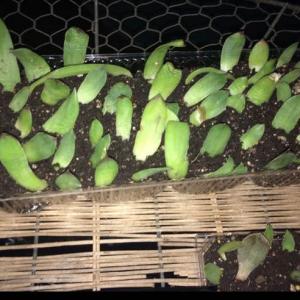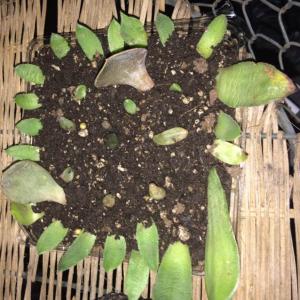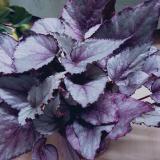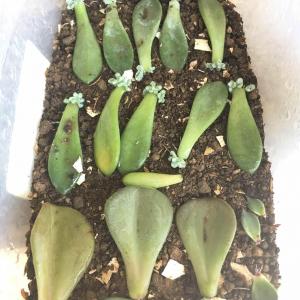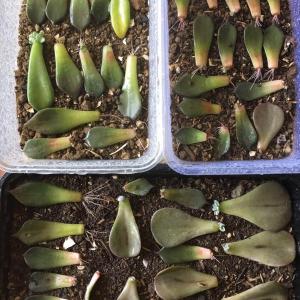成长记
stureburk
2017年07月29日

Picked a couple of leaves that have started sprouting from the floor of my other plants pot. Easiest propagation ever.


1
0
求助
Alisha Adent
2017年05月23日

I am attempting propagation for the first time. Any tips for success?


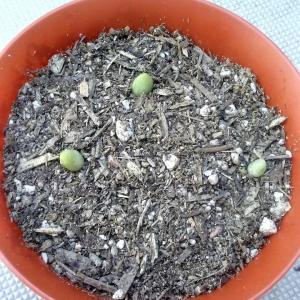





2
0
Lintonion:They thrive when you let Theyre soil completely dry out before you water them. And dont drown them! I use a mist bottle and it works perfectly! Good luck!
成长记
Alisha Adent
2017年05月23日

I new added a "Donkey tail (sedum morganianum) propagation attempt" in my "garden"
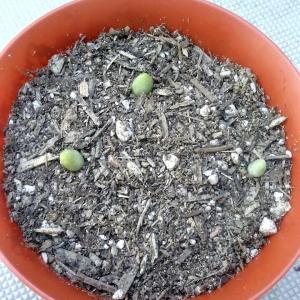

1
0
成长记
Alisha Adent
2017年05月23日

I new added a "String of buttons (crassula perforata) propagation attempt" in my "garden"
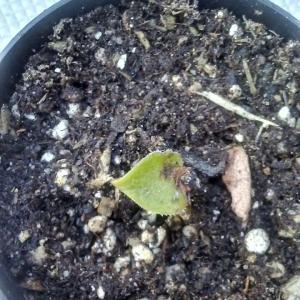

1
0
成长记
Alisha Adent
2017年05月23日

I new added a "String of buttons (crassula perforata) propagation attempt" in my "garden"
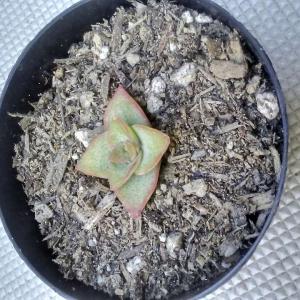

1
0
成长记
Alisha Adent
2017年05月23日

I new added a "Mini jade (crassula ovata) propagation experiment" in my "garden"


0
0
求助
Lucky Coyote
2017年05月23日

how do I take a rosette or two off of my tiger jaws for propagation without hurting it, and is the leaf in the second picture rotting? it's rather soft compared to the rest of the plant
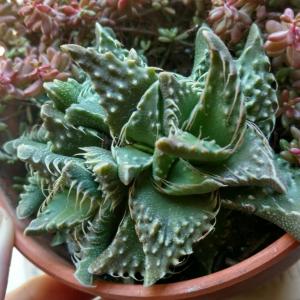
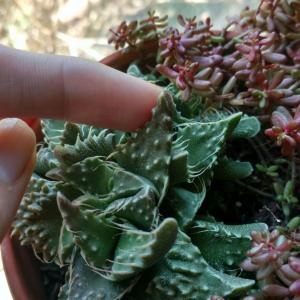


1
0
Ueca:I haven't done it myself, but research tells me that the stem is a crucial part to have on the cutting if you want to propagate it.
文章
Martha
2017年05月22日

Learn how to grow romanesco, growing romanesco broccoli is rewarding. It is a very decorative and ornamental cauliflower with exotic taste.
USDA Zones — 3 – 11
Propagation Method — Seeds
Difficulty — Moderate
Other Names — Brassica oleracea botrytis (latin name), Romanesco broccoli Romanesco Cauliflower, Romanesque cauliflower, Buzzy Broc
Romanesco broccoli is also called “Broccoli Apple” and “Cauliflower with Turrets”. It is a Mediterranean plant, native to Italy, especially of Rome and is an Italian cousin of broccoli and cauliflower.
It is a very decorative and ornamental cauliflower with exotic taste. You can even grow it in the flower garden and admire it.
Romanesco is rich in vitamin C and minerals. It has a mild taste than other cauliflowers and slightly sweet flavor.
Planting
Seed sowing is done in spring and summer. If growing romanesco in cooler zones, sow the seeds 4 – 6 weeks prior to planting outside. Sow the seeds 2 cm deep. While planting the seedlings outside leave 50 cm (2 feet) of space in all directions.
If growing in subtropical and tropical zones you can plant it in fall or in winter.
Companion Plants
Dill, artichokes, chard, beet, borage, chamomile, nasturtium, carrot, celery, cucumber, spinach, beans, hyssop, lettuce, mint, marigold, oregano, peas, potatoes, rosemary, sage, thyme.
Incompatible Plants
Garlic, chives, shallots, strawberries, turnip, onion, parsnip, leek, radish, rutabaga, tomatoes.
Requirements for Growing RomanescoSoil
Humus and compost rich soil that is well drained is recommended.
Sun
Growing romanesco in sunny spot for more yield.
Watering
Like most of the brassicas it enjoys frequent and regular watering.
Romanesco Care
Romanesco broccoli care is similar to other cauliflowers and cabbages.
Fertilizer
Mix compost and 10 – 10 – 10 slow release fertilizer at the time of planting. Fertilize it with high in nitrogen fertilizer one month after planting.
Mulching
Do mulching to keep the soil weed free and conserve moisture.
Pests and Diseases
Flea beetles, gall weevil, whiteflie, aphids and moths. Snails and slugs are fond of seedlings. Besides this it is infected by blight, clubroot and mildew.
Harvesting
Generally, romanesco is ready to harvest in 75 – 100 days after planting. Pick the head when they are tight and dense and use fresh as soon as possible.
Crop rotation

USDA Zones — 3 – 11
Propagation Method — Seeds
Difficulty — Moderate
Other Names — Brassica oleracea botrytis (latin name), Romanesco broccoli Romanesco Cauliflower, Romanesque cauliflower, Buzzy Broc
Romanesco broccoli is also called “Broccoli Apple” and “Cauliflower with Turrets”. It is a Mediterranean plant, native to Italy, especially of Rome and is an Italian cousin of broccoli and cauliflower.
It is a very decorative and ornamental cauliflower with exotic taste. You can even grow it in the flower garden and admire it.
Romanesco is rich in vitamin C and minerals. It has a mild taste than other cauliflowers and slightly sweet flavor.
Planting
Seed sowing is done in spring and summer. If growing romanesco in cooler zones, sow the seeds 4 – 6 weeks prior to planting outside. Sow the seeds 2 cm deep. While planting the seedlings outside leave 50 cm (2 feet) of space in all directions.
If growing in subtropical and tropical zones you can plant it in fall or in winter.
Companion Plants
Dill, artichokes, chard, beet, borage, chamomile, nasturtium, carrot, celery, cucumber, spinach, beans, hyssop, lettuce, mint, marigold, oregano, peas, potatoes, rosemary, sage, thyme.
Incompatible Plants
Garlic, chives, shallots, strawberries, turnip, onion, parsnip, leek, radish, rutabaga, tomatoes.
Requirements for Growing RomanescoSoil
Humus and compost rich soil that is well drained is recommended.
Sun
Growing romanesco in sunny spot for more yield.
Watering
Like most of the brassicas it enjoys frequent and regular watering.
Romanesco Care
Romanesco broccoli care is similar to other cauliflowers and cabbages.
Fertilizer
Mix compost and 10 – 10 – 10 slow release fertilizer at the time of planting. Fertilize it with high in nitrogen fertilizer one month after planting.
Mulching
Do mulching to keep the soil weed free and conserve moisture.
Pests and Diseases
Flea beetles, gall weevil, whiteflie, aphids and moths. Snails and slugs are fond of seedlings. Besides this it is infected by blight, clubroot and mildew.
Harvesting
Generally, romanesco is ready to harvest in 75 – 100 days after planting. Pick the head when they are tight and dense and use fresh as soon as possible.
Crop rotation
0
0
文章
Juze
2017年05月22日

Learn how to grow dragon fruit, it’s one of the most strange looking subtropical fruit you’d like to grow in your garden. Growing dragon fruit is fairly easy both outdoors or in the pot.

USDA Zones— 9 to 11
Propagation Method — Seeds, vegetative propagation
Difficulty — Moderate
Soil pH — 6 to 7
Other names — Indonesia buah naga, Khmer sror kaa neak, Thai kaeo mangkon, nanettika fruit, Kaktus madu, Long guo, Cereus triangularis, Thanh long, Strawberry Pear, Cactus fruit, Night blooming Cereus, Belle of the Night, Jesus in the Cradle.
Dragon fruit, also known as pitahaya or pitaya, belongs to the cactus family. Its flowers are unique and one among the largest in the world. It has a diameter of 25 cm and is about 30 cm long. One more feature of its bloom is: it only opens for one night and exudes inviting fruity fragrance.
Growing Regions
Dragon fruit is native to Central America and grown throughout the subtropical and tropical part of China, Israel, Vietnam, Malaysia, Thailand and
Nicaragua.
How to Plant and Grow Dragon Fruit
Dragon fruit plant is actually a climbing cactus and needs support to climb on, usually as the plant becomes mature it forms aerial roots from the branches and find something to climb. So, it’s best if you’re growing dragonfruit, find something to support your plant.
Dragon fruit is a sub tropical plant, it loves heat and sun but it’s better to plant it in a spot that remains dry and receives only partial sun.
If you’re living in more temperate climate or if you’re an urban gardener and don’t have much space, grow dragon fruit in pot, it’s fairly easy to grow and adapts itself well in containers. In pot you can move and overwinter it to save from frost as pitaya plant can survive only short period of freezing temperature (below 28 F is detrimental) and frost.
PropagationGrowing Dragon Fruit from Seed
With a knife, divide dragon fruit in half and scoop out the black seeds from the pulp. Wash the pulp off the seeds. Put these seeds on a moist paper towel and leave them overnight.
Fill the germinating tray or small pot with well draining but poor starting mix. You can make it yourself by mixing one part peat and one part perlite. Sprinkle the seed on soil surface and cover that with a thin layer of growing medium that barely covers the seeds.
Thoroughly moisten the soil using sprayer and cover the pot with plastic wrap. Keep the soil moist until seeds germinate, which will take around 15 to 30 days.
After the seeds germinate, uncover the plastic and transplant them to bigger pots when necessary.
Growing Dragon Fruit from Cuttings
To learn how to propagate dragon fruit from cuttings, read this.
Soil
For growing dragonfruit, well draining soil that is sandy is better. A mixture of sand in garden soil would be appropriate. It is forgiving to poor soil.
Water
Since the dragon fruit is a cactus, water it moderately with care like you do with other succulents. Water only when soil dries out completely.
Fertilizer for Growing Dragonfruit
Fertilize dragon fruit with balanced fertilizer every month when the plant is active in its growing season. Stop fertilizing in winter if growing in colder climate. Application of aged manure or compost can also be done time to time.
Dragon Fruit Pollination
Many dragon fruit varieties are self pollinating but there are some that requires cross pollination. If your dragon fruit is unable to do self pollination, you’ll need to grow two or more dragon fruit plants closely for cross pollination. As dragon fruit flowers are nocturnal, its pollination depends on moths and bats. For assurance, you can also do self pollination at night.
Harvest
Harvest dragon fruit when its skin color changes from bright green to red or pink. Its fruit is oval to ovate in shape and 10 to 15 cm long and forms 30 to 50 days after flowering.
Pericarp of dragon fruit is rough and scaly and is usually pink in color. However, there are also red, or yellow dragon fruits depending on the variety. The flesh is located in the interior is white and contains black seeds.
Pests and Diseases

USDA Zones— 9 to 11
Propagation Method — Seeds, vegetative propagation
Difficulty — Moderate
Soil pH — 6 to 7
Other names — Indonesia buah naga, Khmer sror kaa neak, Thai kaeo mangkon, nanettika fruit, Kaktus madu, Long guo, Cereus triangularis, Thanh long, Strawberry Pear, Cactus fruit, Night blooming Cereus, Belle of the Night, Jesus in the Cradle.
Dragon fruit, also known as pitahaya or pitaya, belongs to the cactus family. Its flowers are unique and one among the largest in the world. It has a diameter of 25 cm and is about 30 cm long. One more feature of its bloom is: it only opens for one night and exudes inviting fruity fragrance.
Growing Regions
Dragon fruit is native to Central America and grown throughout the subtropical and tropical part of China, Israel, Vietnam, Malaysia, Thailand and
Nicaragua.
How to Plant and Grow Dragon Fruit
Dragon fruit plant is actually a climbing cactus and needs support to climb on, usually as the plant becomes mature it forms aerial roots from the branches and find something to climb. So, it’s best if you’re growing dragonfruit, find something to support your plant.
Dragon fruit is a sub tropical plant, it loves heat and sun but it’s better to plant it in a spot that remains dry and receives only partial sun.
If you’re living in more temperate climate or if you’re an urban gardener and don’t have much space, grow dragon fruit in pot, it’s fairly easy to grow and adapts itself well in containers. In pot you can move and overwinter it to save from frost as pitaya plant can survive only short period of freezing temperature (below 28 F is detrimental) and frost.
PropagationGrowing Dragon Fruit from Seed
With a knife, divide dragon fruit in half and scoop out the black seeds from the pulp. Wash the pulp off the seeds. Put these seeds on a moist paper towel and leave them overnight.
Fill the germinating tray or small pot with well draining but poor starting mix. You can make it yourself by mixing one part peat and one part perlite. Sprinkle the seed on soil surface and cover that with a thin layer of growing medium that barely covers the seeds.
Thoroughly moisten the soil using sprayer and cover the pot with plastic wrap. Keep the soil moist until seeds germinate, which will take around 15 to 30 days.
After the seeds germinate, uncover the plastic and transplant them to bigger pots when necessary.
Growing Dragon Fruit from Cuttings
To learn how to propagate dragon fruit from cuttings, read this.
Soil

For growing dragonfruit, well draining soil that is sandy is better. A mixture of sand in garden soil would be appropriate. It is forgiving to poor soil.
Water
Since the dragon fruit is a cactus, water it moderately with care like you do with other succulents. Water only when soil dries out completely.
Fertilizer for Growing Dragonfruit
Fertilize dragon fruit with balanced fertilizer every month when the plant is active in its growing season. Stop fertilizing in winter if growing in colder climate. Application of aged manure or compost can also be done time to time.
Dragon Fruit Pollination
Many dragon fruit varieties are self pollinating but there are some that requires cross pollination. If your dragon fruit is unable to do self pollination, you’ll need to grow two or more dragon fruit plants closely for cross pollination. As dragon fruit flowers are nocturnal, its pollination depends on moths and bats. For assurance, you can also do self pollination at night.
Harvest
Harvest dragon fruit when its skin color changes from bright green to red or pink. Its fruit is oval to ovate in shape and 10 to 15 cm long and forms 30 to 50 days after flowering.
Pericarp of dragon fruit is rough and scaly and is usually pink in color. However, there are also red, or yellow dragon fruits depending on the variety. The flesh is located in the interior is white and contains black seeds.
Pests and Diseases
0
0






